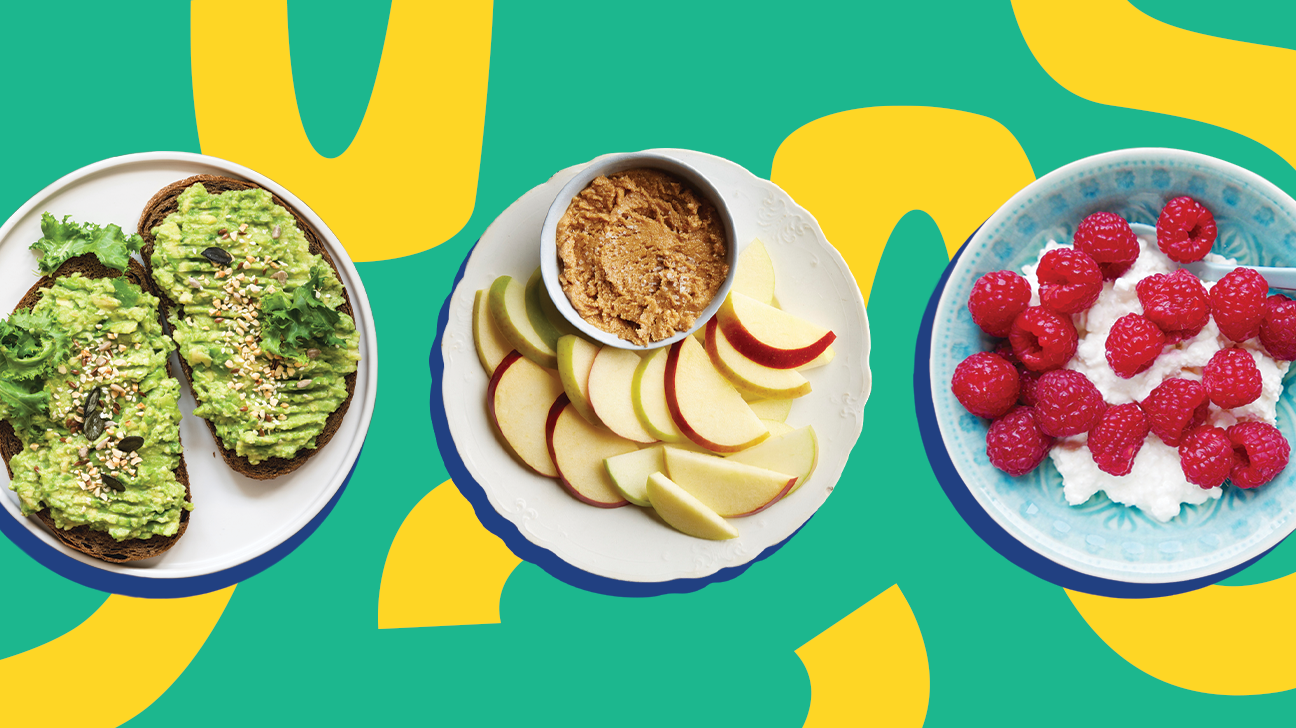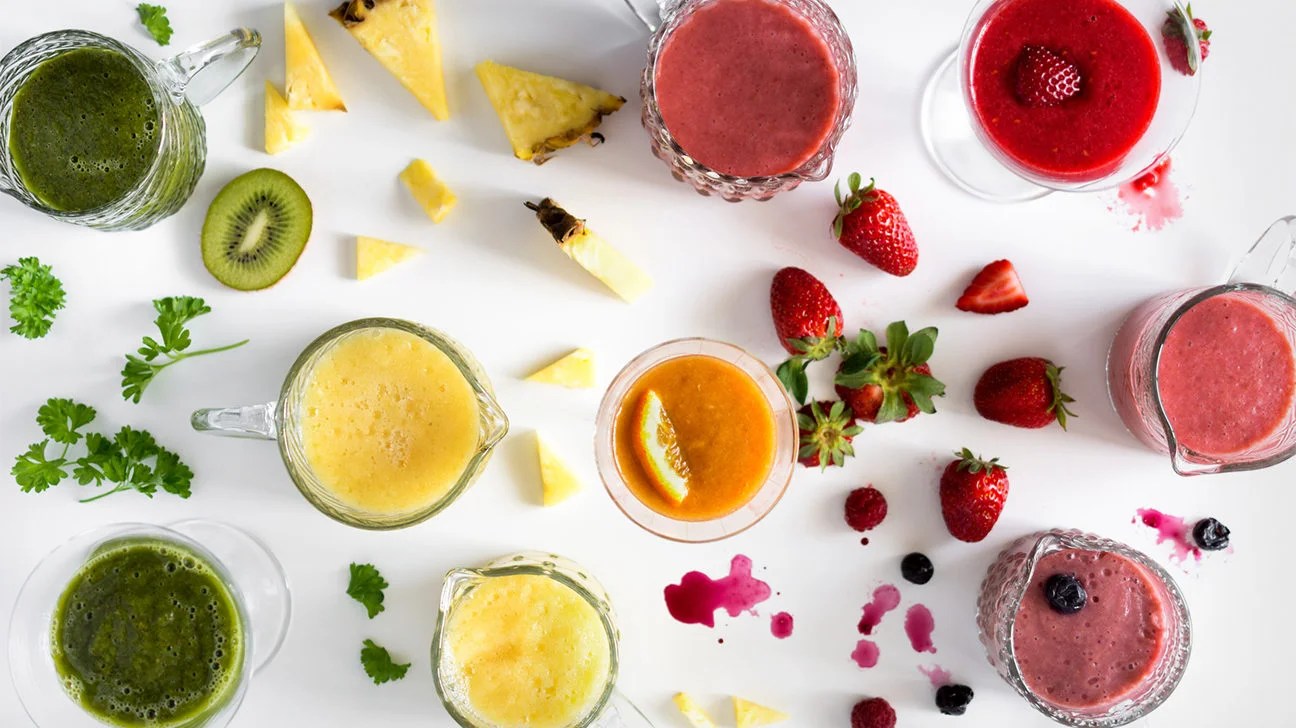The Ultimate Healthy Snack Guide for People Who Love to Eat
Created for Greatist by the experts at Healthline. Read more
If you buy something through a link on this page, we may earn a small commission. How this works.
 Share on Pinterest
Share on PinterestIt’s 3 p.m. and your work emails are quickly escalating from charming sentences with smiley face emojis to writing the entire email body in the subject line — in all caps. The hunger monster has arrived, loud and proud, and you (and all your coworkers) know it. But what to eat that won’t ruin your whole day?
Need a healthy option from your local grocery store? Check.
Want to batch prep some balanced bites? Check.
Looking for something vegan or high in protein for your unique dietary needs? Double check.
What about something you can share with your toddlers or kids? Mama, we got that covered too.
We’ve compiled over 50 dietitian-approved snacks to help you satisfy those cravings and fuel your busy days. 😄
- Apple and almond butter. What’s not to love about this OG sweet and salty snack? Sweet, juicy apple slices and salty, creamy almond butter not only satisfy practically every craving, but this power combo also delivers fiber, protein, and healthy fats.
- Greek yogurt and berries. With 10 grams of protein per 1/2 cup, Greek yogurt is an ideal snack to keep the hunger beast at bay. And when paired with a handful of fiber-rich berries for natural sweetness, you know you’ll be good until lunch.
- Hummus and pita. Hummus is a classic snack for a reason — it’s got fiber, protein, and good fats, not to mention it’s plant based and naturally gluten free. Pair it up with some veggies or pita for a solid morning or afternoon nosh.
- Chia pudding. For you sweet tooth snackers, chia pudding is a nutritious way to prep for a busy day while still bringing those dessert vibes. Just mix 3 tablespoons of chia seeds with 1 cup of the milk of your choice and let it sit in the fridge overnight. Then sweeten or season to taste, and dive in.
- Hard-boiled eggs. With 7 grams of powerful protein in a perfect portable shell, hard-boiled eggs are a satisfying classic that’ll keep you full and focused.
- Edamame. Edamame shouldn’t just be for sushi night. It’s packed with plant based protein, and preparing it is as easy as running a little warm water over frozen pods.
- Yogurt and fruit smoothie. Smoothies don’t have to be complicated. We suggest including a source of protein (yogurt, cottage cheese, or protein powder), a serving of fruit (banana, berries, peaches), a handful of greens (baby spinach works well), and the healthy fat of your choice (nut butter, avocado, hemp hearts or chia). Blend until smooth and get sipping.
- Avocado toast. Who doesn’t like the satiating combination of whole-grain toast with healthy fat-rich avo? Top it off with a poached egg to turn snack time into a hearty meal!
- Celery, peanut butter, and raisins. Remember ants on a log? Bring it back to basics with this crunchy, savory, sweet snack loaded with the satisfying combination of fiber, protein, and fat.
- High fiber crackers and cheese. Whether you’re a hard cheddar fan or into something creamy and spreadable like chèvre, pairing the staying power of calcium-rich cheese with a high fiber crunchy cracker can help kill that afternoon energy dip STAT.
- Whisps. Cheese lovers, rejoice! You can get your cheese fix with just 1 gram of carbs per serving, and 10 to 12 grams of protein in a crispy crunchy bite.
- Epic Provisions Baked Pork Rinds. While most pork rind products are loaded with sodium and fat from the fryer, these bad boys are light, low carb (0 grams!), and deliver 11 grams of protein per serving.
- Keto Pepperoni Pizza Bagel Bites. Hello, the 90s are calling and they want you to smash some bagel bites! While we can’t promise you won’t burn your mouth, we can promise this version is low in carbs, crazy delicious, and hella nostalgic.
- Cauliflower hummus. Craving the savory goodness of hummus without the carbs from beans? We got you. This cauliflower dip is loaded with rich sesame flavor and pairs perfectly with crunchy low carb veggies.
- Notty Foods Peppermint Bark. Chocolate that’s low carb? What is this sorcery?! This high protein chocolate bark tastes like a handful of Andes chocolates but has no added sugar and 11 grams of protein per serving.
- Skotidakis Tzatziki dip and veggies. Made with non-fat Greek yogurt and packed with fresh cucumber and garlic, this 50 calorie per serving dip is a tasty way to sneak in your 5 to 10 servings of daily veg.
- Two-ingredient strawberry popcorn. Popcorn is not only super fun to eat, but is a surprisingly low calorie snack, with just 30 calories per popped cup! Add a little sprinkling of freeze-dried berries and you’ve got a naturally sweet and colorful treat without the need for added sugar or salt.
- Annie Chun’s organic seaweed snacks. Craving something savory and crunchy without the calories? These crispy roasted seaweed sheets have just 30 calories per pack and are a tasty alternative to chips.
- Baked kale chips. We love chips, but hate the preservatives, fat, and sodium in every bite. These oil-free kale chips are seasoned with nutritional yeast, lemon, and cayenne — plus they offer a wicked crunch for those days where you know you can’t eat just one.
- Shrimp cocktail. Raw bar doesn’t have to be saved for weddings or cocktail parties. One medium shrimp has just 7 calories, while a teaspoon of cocktail sauce has only 5, meaning you can have a dozen with tangy dip for under 100 calories!
- KIND Simple Crunch Bar. If you’re craving crunch on the run, this is the bar for you. While a lot of bars are packed with a laundry list of ingredients, this two-pack bar contains just 8 simple ingredients, including 100 percent whole-grain oats and nut butter.
- Biena Chickpea Snacks. For 140 calories per package with 6 grams each of fiber and plant based protein, you’ll make sure every bag, desk, and locker in your life is fully stocked with this convenient snack.
- Peanut butter chocolate protein balls. While most energy balls are nothing more than high carb dates and a little nut butter, we like that these ones are actually low in sugar, vegan, gluten free, and keto friendly. Plus, they taste like a peanut butter cup (#Yaaas).
- Prana Organic Maca Power chocolate bark. Need your chocolate fix in a hurry? We got you covered with this superfood loaded dark bark. Made with whole grains, almonds, and a sprinkle of maca (did we mention you get 4 grams of protein per serving?) it’s the perfect way to crush those afternoon cravings on the go.
- 88 Acres unsweetened watermelon seed butter pouch with whole-grain crackers. We didn’t even know you should eat watermelon seeds, let alone that they make a delicious butter! We love this protein-rich seed butter smeared on whole-grain crackers (or squirted right into your mouth), and the single-serve pouches make them so easy for transport.
- Cottage cheese with sour cherries. A powerful bedtime duo, the casein in the cottage cheese slowly digests to keep you full all night long, while research suggests that sour cherries may ease symptoms for people with insomnia.
- Cherry banana almond baked oatmeal. Oatmeal doesn’t have to be saved for breakfast! The combination of whole grains, magnesium rich banana, and melatonin packed almonds all have been shown to help improve sleep.
- Kiwi yogurt parfait. Like cottage cheese, yogurt is a great source of protein to keep you from tiptoeing down to the pantry for a midnight nosh. Meanwhile, research suggests that kiwi may help improve total sleep time and sleep efficiency.
- Hope Foods chocolate cashew and almond dip with banana. For you chocoholics, you’re gonna to need to get on this plant based dip that has only 4 grams of sugar per serving. Paired with a little sliced banana, it’s the ultimate chocolatey nightcap.
- Lesser Evil “No Cheese” Cheesiness Popcorn. For nights you’re actually going to Netflix and chill, this organic plant based cheesy popcorn is a perfect stand-in for traditional microwave popcorn. And with 4 grams of fiber, 2 grams of protein, and just 110 calories per serving, it’s a super satisfying late night snack.
- Seapoint Farms dry roasted edamame. Chip fans, you’re going to love the epic crunch factor of these dry roasted edamame. With a minimal ingredient list and 13 grams of protein per serving, they may become your new go-to bedtime snack.
- Trader Joe’s Tomato and Basil Hummus with baby carrots and celery. Hummus that makes celery taste like pizza but only has 35 calories per 2 tablespoons? Yes please! 🙋♀️🙋♂️
- Trader Joes Banana Almond Butter Protein Smoothie. Love that sweet and salty combo of a banana smeared with nut butter, but need something super portable for a post workout nosh? This drinkable snack packs a solid 14 grams of protein and 5 grams of fiber in each 320 calorie bottle.
- 365 Striders Snack trail mix. While most trail mixes are loaded with added sugar and salt, this version from Whole Foods provides a satisfying combination of nuts and sweet raisins without any additives.
- 365 Greek Yogurt Strawberry Frozen Bars. Sometimes you need a lil’ something sweet to finish off the day. This 80 calorie Froyo bar is sweet, creamy, and packs an impressive 4 grams of protein thanks to the addition of real low fat Greek yogurt.
- Kirkland Signature protein bars. With 15 grams of fiber, 21 grams of protein, and only 3 to 4 grams of net carbs per 190 calories, these gluten free bars are a perfect post-workout snack!
- Made Good Granola Minis. Organic, gluten free, allergen free, and packed with one serving of vegetables per pack, these crunchy sweet snacks are a school-safe fave.
- Chocolate dipped banana roll ups. With a high fiber cereal for crunch, some natural nut butter for healthy fats and protein, and a little chocolate to sweeten the deal, these roll up pops are a perfect healthy after school snack.
- Bitsy Cheddar Chia Smart Crackers. Made in a nut-free facility and with the goodness of real veggies and heart-healthy chia seeds, these organic non-GMO snacks give you that “junk food” vibe without the junk.
- Mini broccoli and cheese egg muffins. Packed with iron, protein and some stealthy veggies, these bite sized savory muffins are perfect for active kids on the go.
- Munk Pack Maple Pear Quinoa Oatmeal Fruit Squeeze Packs. Parents love the convenience (and clean up) from squeeze pouches, and we love that these ones are packed with fiber, plant based protein, real fruit and omega-3 fatty acids! They’re like overnight oats, without the prep (#MomWin)!
- Carrot oat bars. These carrot oat bars are super easy to make in a food processor and can be made ahead of time to enjoy all week long! They’re also full of fiber and veggies and low in added sugar, but they totally taste like dessert!
- Gluten free vegan protein bars. These no-bake bars are gluten free, vegan, and hella tasty, made from a combination of nut butter, maple syrup, flaxseed, oats, and protein powder.
- Peanut sriracha hummus. Add a little kick to your hummus game with this savory and spicy peanut sriracha dip that packs a satisfying combination of protein, fiber, and good fats.
- Protein brownies. With just five ingredient and less than 100 calories and 8 grams of protein per brownie, these little cuties can be baked, frozen, and pulled out for those days you really need a chocolate hit.
- Peanut butter cup quinoa energy bites. These easy energy balls are perfect to beat the mid-morning blues, plus they only have five ingredients (one of which being delish chocolate chips).
- Chocolate protein popcorn. We love popcorn, we love chocolate, and we definitely love protein, so this batch-prepped snack is a dream snack morning, noon, or night.
- Wholly Guacamole 100 Calorie Mini Cup and veggies. Vegan, paleo, and keto-friendly, we all love guac but we hate dealing with tricky avocados. Problem solved! These 100 calorie cups have no preservatives, are made with real hand-scooped Hass avos, and we don’t have to wait for the perfect moment of ripeness to dive in.
- Spicy TUNO with Sriracha on whole-grain crackers. This non-GMO, gluten free fish alternative has the flaky texture of real tuna plus all of its protein and omega-3 rich benefits, but packed into a more sustainable plant based product. Pile it onto your go-to cracker for a satisfying afternoon snack.
- Chocolate hazelnut granola bars. Healthy bars that taste like Nutella? It’s a vegan miracle! Loaded with fiber from whole grains, natural sweetness from ripe banana and dates, and healthy fats from the hazelnuts, hemp hearts, and almond butter, these bars are a must.
- Munk Pack protein cookie. Peanut butter chocolate chip cookies with 18 grams of plant based protein? Sign us up! These babies are conveniently packaged so they’re easy to throw in your bag and contain no gluten, soy, dairy, egg, GMOs, or sugar alcohols.
- Spicy watermelon fries. Sweet and spicy and bursting with hydration, consider this the love child of your favorite fruit (watermelon) and favorite food group (fries). You’re welcome.
- Litehouse Greek yogurt smoothie. These single serving smoothies pack 13 grams of powerful protein per bottle and are made without any artificial dyes or preservatives. They’ve got five different fruity combinations to try, but right now we’re really digging the Raspberry Passion.
- SimplyProtein chips. Available in three swoon-worthy flavors (we’re kinda obsessed with the Spicy Chili), each bag packs 15 grams of protein and only one gram of sugar. Crunch on, snack lovers!
- Moon cheese. Crunchy high protein cheese? Get in my mouth! These crispy little balls are packed with savory flavor and 11 grams of protein per serving.
- Bada Bean Bada Boom broad beans. With 7 grams of protein, and 6 grams of fiber in each single serving 100-calorie pack, these are addictively crunchy and a perfectly balanced snack. We’re partial to the new Sweet Onion & Mustard, but they have a dozen tasty options to try.
- Stryve Foods Original Beef Biltong. While a lot of jerky products are packed with added sugar and preservatives, Stryve Foods has 0 grams of sugar, 16 grams of protein and only five ingredients.
- 2 Ingredient Protein Nice Cream. Yep, you read that right. If you puree together cottage cheese and your favorite frozen fruit, you end up with a creamy dreamy high protein Froyo without any added sugar.
Now, go forth and snack!
https://greatist.com/health/healthy-snacks
» Comments Off on The Ultimate Healthy Snack Guide for People Who Love to Eat


